A Walk in the Park
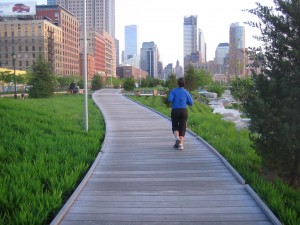
One of the great joys of living downtown over the past decade has been watching the transformation of the West Side riverfront: This once-neglected stepchild has turned into a princess. “Every now and then I’ll hear someone talking on his cell phone,” said Connie Fishman, president of the Hudson River Park Trust, the organization that is designing, building, and operating the five-mile Hudson River Park. “And he’ll be saying, ‘You won’t believe what’s happened to this area!’”
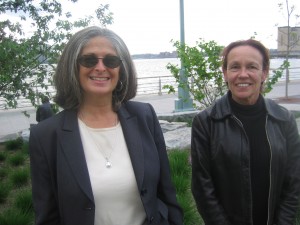
As dramatic as the changes have been, they’ve also been gradual, with newly renovated sections debuting years apart and without much fanfare. This is the first full summer that the northern half of the .7-mile Tribeca section will be open. Impressed by the elegance of the design—it blends in with the completed sections to the north, but it also manages to feel unique—I asked the Hudson River Park Trust if someone would walk through the new section with me. Not only did Connie Fishman (above, left) agree to show me around, she persuaded landscape architect Signe Nielsen (above, right) to join us. A partner in the firm of Mathews Nielsen, which was partially responsible for the Tribeca section, Nielsen has lived in Tribeca for 35 years and was involved in creating the park’s master plan.
“The planning for Hudson River Park took place from 1978 to 1998, with construction starting in 2000,” said Fishman. At 550 acres, the park is the largest open-space project to be built in Manhattan since Central Park. It was divided into four sections—Clinton/Midtown, Chelsea, Greenwich Village, and Tribeca (ending at Chambers Street, though the park officially includes the bike path down to Battery Place)—with each section having its own team of architects. Every section was required to include boating access and space for both passive and active recreation; they also had to accommodate the bike path, the esplanade, and a handful of design elements, such as the balustrade and the lighting. The HRPT wanted a global identity for the park—and to facilitate maintenance. (Having to stock 18 different types of light bulbs would be a pain.)
The sections shared a significant challenge: narrowness. “What do you do with 70 to 80 feet?” asked Nielsen. As we walked north from the park entrance at Laight Street, she recalled with relief that the federal government agreed to waive the requirement for a breakdown lane on the southbound section of West Street. “That saved us eleven feet of park.”
Even if the architects didn’t have much in the way of space, they did have freedom to design independently of the other sections. The most distinctive aspect of the northern Tribeca section—which runs from Laight Street up to pier 40, at Houston—is the boardwalk extending over a series of manmade hills. At its peak, the boardwalk is five feet above the esplanade; that’s also the highest spot in the entire park. “We wanted to create another path in a narrow space,” said Nielsen. “But if the boardwalk were the same level as the esplanade, what would be the point?”
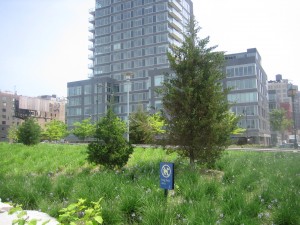
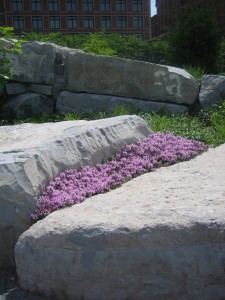 The hills, which allow unobstructed river views, are landscaped like grasslands. “There are four seasons of plantings, so there’s always something happening,” said Nielsen. “In February, the witch hazel blooms with red berries.” The trees they selected had to be more than attractive: They had to be able to bend in the wind. The red cedars were intentionally chosen to be different sizes. Nielsen said they remind her of people, adults and children here and there. The landscapers are experimenting with planting thyme (currently flowering pink, white, and purple) in the crevices between the large, irregularly shaped stones that line the esplanade, functioning as retainers, seating, and entertainment for the children who love clambering over them.
The hills, which allow unobstructed river views, are landscaped like grasslands. “There are four seasons of plantings, so there’s always something happening,” said Nielsen. “In February, the witch hazel blooms with red berries.” The trees they selected had to be more than attractive: They had to be able to bend in the wind. The red cedars were intentionally chosen to be different sizes. Nielsen said they remind her of people, adults and children here and there. The landscapers are experimenting with planting thyme (currently flowering pink, white, and purple) in the crevices between the large, irregularly shaped stones that line the esplanade, functioning as retainers, seating, and entertainment for the children who love clambering over them.
How the park will be used has been factored into every decision. Wherever there’s a crosswalk, for instance, there has to be a passage leading through the bike path to the esplanade. And to help with navigation, the cross streets’ names are engraved into the esplanade. Some intersections have plazas with metal tables and chairs. “At the beginning, I wasn’t sure anyone would want to sit there,” said Fishman. “But they’ve been very popular. I think it’s because they’re less of a commitment—you can just pop in and grab a seat.” Civilians aren’t the only people the architects have to bear in mind. The esplanade opposite the twin piers at Canal Street has a curve in it that’s just wide enough to accommodate the turning radius of Port Authority vehicles. (Because the piers lead to the Holland Tunnel vents, they’re owned by the Port Authority, which explains why the piers’ light fixtures are different from the park’s.) Rather than have a lone curve bulging out of the esplanade, Nielsen decided to incorporating curves elsewhere in the Tribeca section, embracing them as a motif.
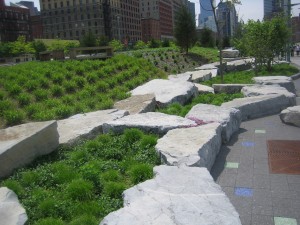 Anyone designing a public space also has to think about how it might get abused. The retainer stones have been mortared from behind, to hold them in place (and to stop rats from making nests). And while the unstained wood on the boardwalk and its benches might seem tempting for vandals, they’ll find it tough going. The wood is plantation-grown ipê, a hardwood that’s nearly impossible to carve. In fact, the bolts fastening the planks had to be drilled, because the wood is too hard to hammer nails into.
Anyone designing a public space also has to think about how it might get abused. The retainer stones have been mortared from behind, to hold them in place (and to stop rats from making nests). And while the unstained wood on the boardwalk and its benches might seem tempting for vandals, they’ll find it tough going. The wood is plantation-grown ipê, a hardwood that’s nearly impossible to carve. In fact, the bolts fastening the planks had to be drilled, because the wood is too hard to hammer nails into.
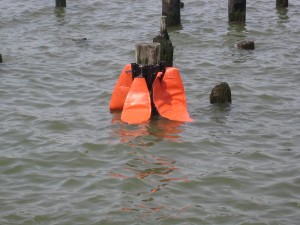 One flourish that exists only in the Tribeca section—blue and green tiles in some of the passages—is purely aesthetic. Larger versions of tiles (two feet by two feet) will be on the plaza that will be located between piers 25 and 26, and even climb up a bit of the walls of some of the piers’ buildings. The park is also home to art. Three large steel sculptures by Mark Gibian, inspired by fish skeletons and ship ribbing, sit next to the esplanade. And on the ghostly pilings of the erstwhile pier 32, south of Canal Street, there are bird sculptures by Fay Chin, and, as a test, an orange plastic “tide flower” by Stacy Levy. The flower’s petals are meant to rise with the tide—it fluctuates five feet every six hours—so that at high tide they spread out and rest on the surface, like a lotus does. (Ron Barons’s nautical-themed sculptures on the old pilings by the Port Authority piers predate HRPT.) Two telescopes allow visitors to look at the real birds who perch on the piles and, should they so choose, the residents inside the new Truffles Tribeca building. (There are more telescopes on the Port Authority’s pier 34.) Nielsen added that it’s her dream to install a filter screen at the far end of the pilings, to catch the river silt until a natural island forms, reachable by kayaks to be launched from pier 26.
One flourish that exists only in the Tribeca section—blue and green tiles in some of the passages—is purely aesthetic. Larger versions of tiles (two feet by two feet) will be on the plaza that will be located between piers 25 and 26, and even climb up a bit of the walls of some of the piers’ buildings. The park is also home to art. Three large steel sculptures by Mark Gibian, inspired by fish skeletons and ship ribbing, sit next to the esplanade. And on the ghostly pilings of the erstwhile pier 32, south of Canal Street, there are bird sculptures by Fay Chin, and, as a test, an orange plastic “tide flower” by Stacy Levy. The flower’s petals are meant to rise with the tide—it fluctuates five feet every six hours—so that at high tide they spread out and rest on the surface, like a lotus does. (Ron Barons’s nautical-themed sculptures on the old pilings by the Port Authority piers predate HRPT.) Two telescopes allow visitors to look at the real birds who perch on the piles and, should they so choose, the residents inside the new Truffles Tribeca building. (There are more telescopes on the Port Authority’s pier 34.) Nielsen added that it’s her dream to install a filter screen at the far end of the pilings, to catch the river silt until a natural island forms, reachable by kayaks to be launched from pier 26.
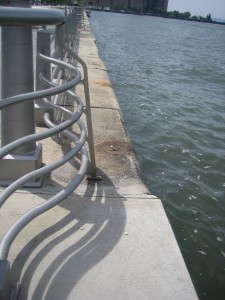 Fishman and Nielsen reminisced about petitioning the Army Corps of Engineers to permit small cantilevered platforms wherever piers once were. In another nod to the past, much of the historic concrete bulkhead was retained—if you look along the river, you can see new parts abutting old, pockmarked areas. The height of the esplanade was dictated by the height of the existing bulkhead, but if global warming raises the water level significantly, renovations will be inevitable. Nielsen said that all the plants in the park are salt-tolerant—to a point.
Fishman and Nielsen reminisced about petitioning the Army Corps of Engineers to permit small cantilevered platforms wherever piers once were. In another nod to the past, much of the historic concrete bulkhead was retained—if you look along the river, you can see new parts abutting old, pockmarked areas. The height of the esplanade was dictated by the height of the existing bulkhead, but if global warming raises the water level significantly, renovations will be inevitable. Nielsen said that all the plants in the park are salt-tolerant—to a point.
Despite the basketball court and three tennis courts, the northern Tribeca area is remarkably tranquil, a counterpoint to the activities that will soon available on the southern end. The upland—i.e., not the piers—will include a skate park and a plaza. It’s scheduled to be completed by the end of 2010, along with pier 25, which will have a miniature golf course, beach volleyball courts, a playground, a dock and moorings, locations for historic boats, and an artificial lawn. (The pier is five blocks long, or 1,000 feet.) Pier 26 is still dependent on funding, but the plans call for a boathouse for non-motorized boats, an estuarium, and a café. Fishman said that in the master plan, the restaurant was called a “funky clam bar.” Tribeca was considerably less gentrified then, and the community board could only come to terms with sanctioning a revenue-generating business in the park by imagining it as something raffish, to match the neighborhood. How times change—which, as the Hudson River Park proves, can be a wonderful thing. —Erik Torkells














